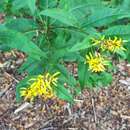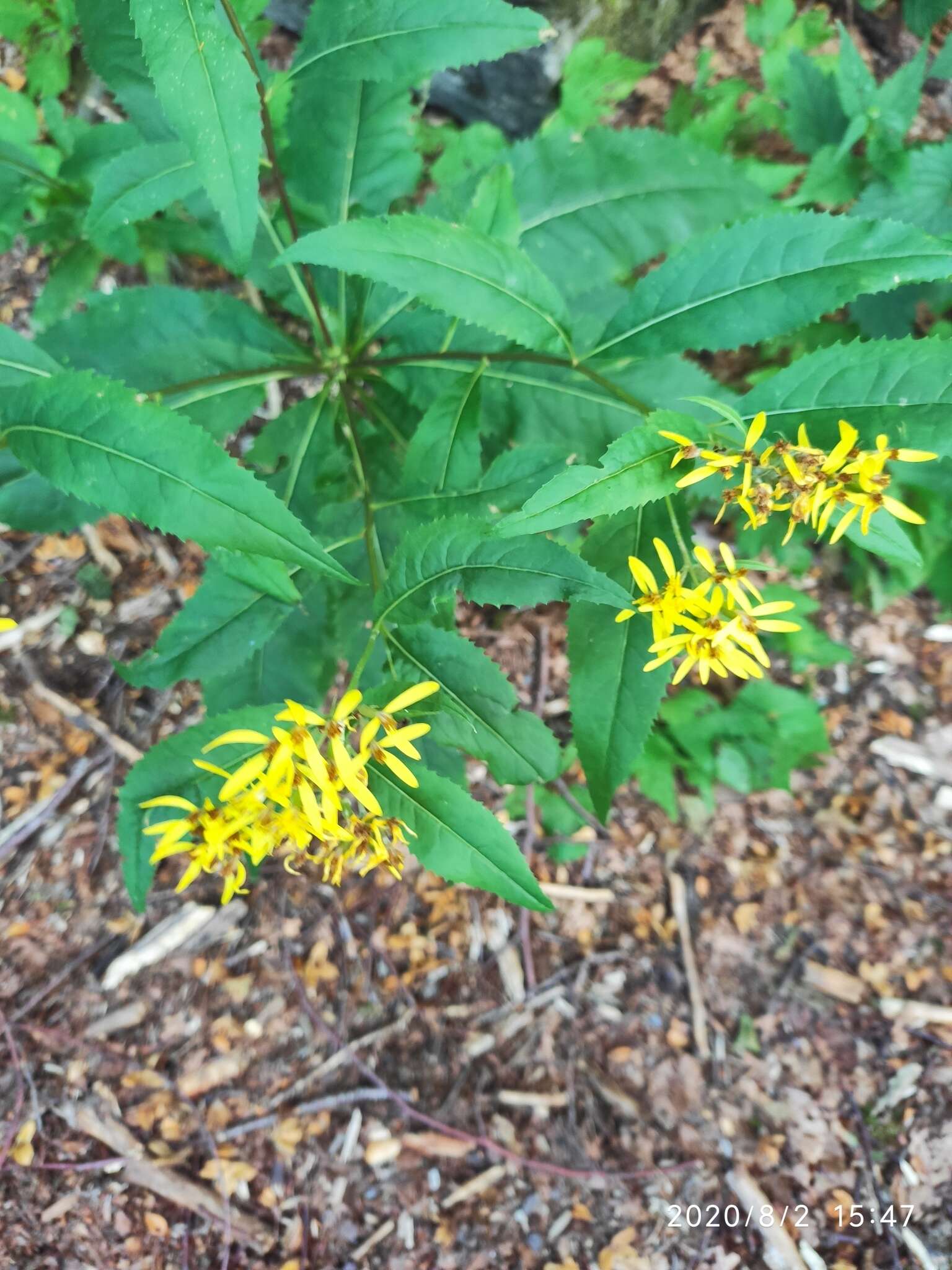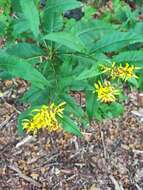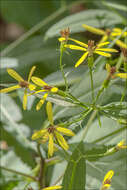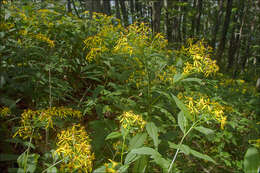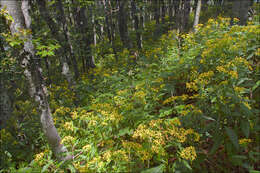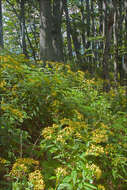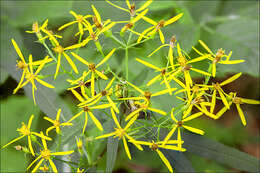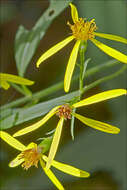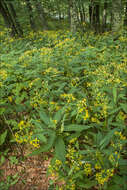-
-
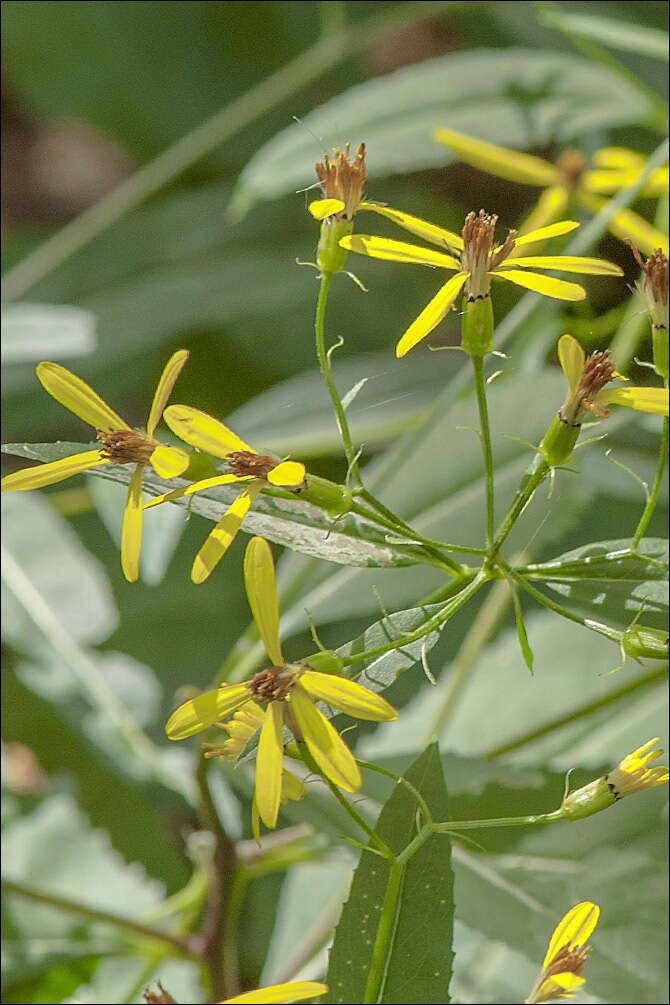
Senecio ovatus (G. Gaertn. & al.) Hoppe ssp. ovatus, syn.: Jacobaea ovata G. Gaertn. & al., Senecio fuchsii C. C. Gmel., Senecio nemorensis subsp. fuchsii (C. C. Gmel.) Ces.Family: Compositae GisekeEN: wood ragwort, DE: Fuchssche Greiskraut, Fuchs-Greiskraut, Fuchskreuzkraut, Kahles Hain-GreiskrautSlo.: Fuchsov grintDat.: Aug. 10. 2008Lat.: 45.28983 Long.: 14.20270Code: Bot_0288/2008_DSC2400Picture file names: from Senecio-ovatus_raw_1 to Senecio-ovatus_raw_10.Habitat: steep mountain slope, east aspect; Fagus sylvatica forest; calcareous ground; in shade, elevation 1.350 m (4.430 feet); average precipitations ~ 2.200 mm/year, average temperature 7-8 deg C, Mountain Sub-Mediterranean phytogeographical region. Substratum: soil.Place: Istria, Uka mountain group, north of Mt. Vojak, almost on top of the mountain ridge above to the road to the top, Rijeka region, Croatia EC.Comment: Senecio ovatus ssp. ovatus is native to central and southeast Europe but it is now naturalized or alien to UK and part of Scandinavia. There are a few very closely related taxa, which differ in slightly in their pubescens, leaf shape and average number of florets in their flower heads. It is not always easy to distinguish them because these traits are all variable. These stands on Mt. Uka, a mountain, which is full of botanical attractions and which dominates (with its 1.401 m height) the whole Kvarner bay of Adriatic Sea and Kvarner archipelago islands, are the largest I've seen.All species od the genus Senecio are seriously poisonous. They contain Pyrrolizidinalkaloides, which are known carcinogen and mutagen substances. Animals dont eat them when grazing, however, if the plants come into hay they may cause serious problems for cattle. Ref.:(1) W.K. Rottensteiner, Exkursionsflora fr Istrien, Verlag des Naturwissenschaftlichen Vereins Krten (2014), p 281.(2) A. Martini et all., Mala Flora Slovenije (Flora of Slovenia - Key) (in Slovenian), Tehnina Zaloba Slovenije (2007), p 669.(3) R. Domac, Flora Hrvatske (Flora of Croatia) (in Croatian), kolska Knjiga, Zagreb (1994), p 357.(4) D. Aeschimann, K. Lauber, D.M. Moser, J.P. Theurillat, Flora Alpina, Vol. 2., Haupt (2004), p 504.Camera: Nikon D70 /Nikkor Micro 105mm/f2.8 and AF-S Nikkor 18-70mm/f3.5-4.5G ED
-
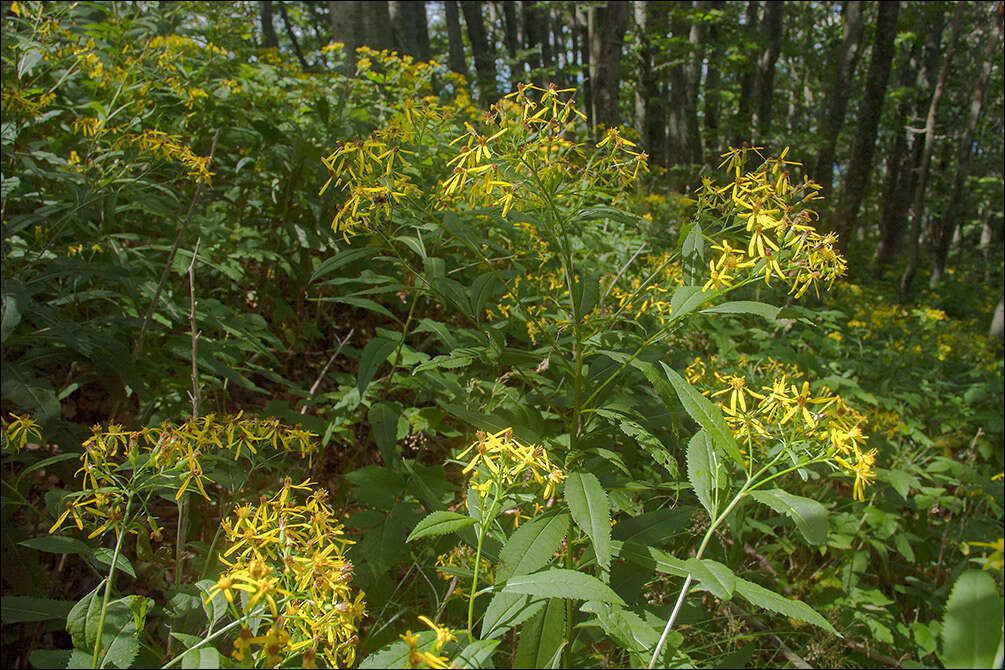
Senecio ovatus (G. Gaertn. & al.) Hoppe ssp. ovatus, syn.: Jacobaea ovata G. Gaertn. & al., Senecio fuchsii C. C. Gmel., Senecio nemorensis subsp. fuchsii (C. C. Gmel.) Ces.Family: Compositae GisekeEN: wood ragwort, DE: Fuchssche Greiskraut, Fuchs-Greiskraut, Fuchskreuzkraut, Kahles Hain-GreiskrautSlo.: Fuchsov grintDat.: Aug. 10. 2008Lat.: 45.28983 Long.: 14.20270Code: Bot_0288/2008_DSC2400Picture file names: from Senecio-ovatus_raw_1 to Senecio-ovatus_raw_10.Habitat: steep mountain slope, east aspect; Fagus sylvatica forest; calcareous ground; in shade, elevation 1.350 m (4.430 feet); average precipitations ~ 2.200 mm/year, average temperature 7-8 deg C, Mountain Sub-Mediterranean phytogeographical region. Substratum: soil.Place: Istria, Uka mountain group, north of Mt. Vojak, almost on top of the mountain ridge above to the road to the top, Rijeka region, Croatia EC.Comment: Senecio ovatus ssp. ovatus is native to central and southeast Europe but it is now naturalized or alien to UK and part of Scandinavia. There are a few very closely related taxa, which differ in slightly in their pubescens, leaf shape and average number of florets in their flower heads. It is not always easy to distinguish them because these traits are all variable. These stands on Mt. Uka, a mountain, which is full of botanical attractions and which dominates (with its 1.401 m height) the whole Kvarner bay of Adriatic Sea and Kvarner archipelago islands, are the largest I've seen.All species od the genus Senecio are seriously poisonous. They contain Pyrrolizidinalkaloides, which are known carcinogen and mutagen substances. Animals dont eat them when grazing, however, if the plants come into hay they may cause serious problems for cattle. Ref.:(1) W.K. Rottensteiner, Exkursionsflora fr Istrien, Verlag des Naturwissenschaftlichen Vereins Krten (2014), p 281.(2) A. Martini et all., Mala Flora Slovenije (Flora of Slovenia - Key) (in Slovenian), Tehnina Zaloba Slovenije (2007), p 669.(3) R. Domac, Flora Hrvatske (Flora of Croatia) (in Croatian), kolska Knjiga, Zagreb (1994), p 357.(4) D. Aeschimann, K. Lauber, D.M. Moser, J.P. Theurillat, Flora Alpina, Vol. 2., Haupt (2004), p 504.Camera: Nikon D70 /Nikkor Micro 105mm/f2.8 and AF-S Nikkor 18-70mm/f3.5-4.5G ED
-
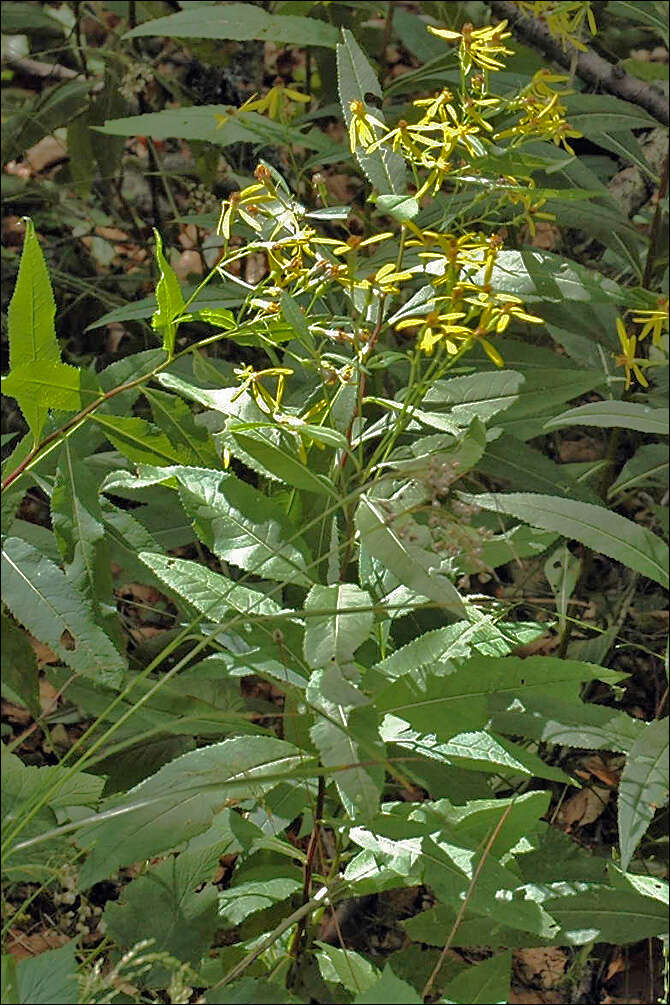
Senecio ovatus (G. Gaertn. & al.) Hoppe ssp. ovatus, syn.: Jacobaea ovata G. Gaertn. & al., Senecio fuchsii C. C. Gmel., Senecio nemorensis subsp. fuchsii (C. C. Gmel.) Ces.Family: Compositae GisekeEN: wood ragwort, DE: Fuchssche Greiskraut, Fuchs-Greiskraut, Fuchskreuzkraut, Kahles Hain-GreiskrautSlo.: Fuchsov grintDat.: Aug. 10. 2008Lat.: 45.28983 Long.: 14.20270Code: Bot_0288/2008_DSC2400Picture file names: from Senecio-ovatus_raw_1 to Senecio-ovatus_raw_10.Habitat: steep mountain slope, east aspect; Fagus sylvatica forest; calcareous ground; in shade, elevation 1.350 m (4.430 feet); average precipitations ~ 2.200 mm/year, average temperature 7-8 deg C, Mountain Sub-Mediterranean phytogeographical region. Substratum: soil.Place: Istria, Uka mountain group, north of Mt. Vojak, almost on top of the mountain ridge above to the road to the top, Rijeka region, Croatia EC.Comment: Senecio ovatus ssp. ovatus is native to central and southeast Europe but it is now naturalized or alien to UK and part of Scandinavia. There are a few very closely related taxa, which differ in slightly in their pubescens, leaf shape and average number of florets in their flower heads. It is not always easy to distinguish them because these traits are all variable. These stands on Mt. Uka, a mountain, which is full of botanical attractions and which dominates (with its 1.401 m height) the whole Kvarner bay of Adriatic Sea and Kvarner archipelago islands, are the largest I've seen.All species od the genus Senecio are seriously poisonous. They contain Pyrrolizidinalkaloides, which are known carcinogen and mutagen substances. Animals dont eat them when grazing, however, if the plants come into hay they may cause serious problems for cattle. Ref.:(1) W.K. Rottensteiner, Exkursionsflora fr Istrien, Verlag des Naturwissenschaftlichen Vereins Krten (2014), p 281.(2) A. Martini et all., Mala Flora Slovenije (Flora of Slovenia - Key) (in Slovenian), Tehnina Zaloba Slovenije (2007), p 669.(3) R. Domac, Flora Hrvatske (Flora of Croatia) (in Croatian), kolska Knjiga, Zagreb (1994), p 357.(4) D. Aeschimann, K. Lauber, D.M. Moser, J.P. Theurillat, Flora Alpina, Vol. 2., Haupt (2004), p 504.Camera: Nikon D70 /Nikkor Micro 105mm/f2.8 and AF-S Nikkor 18-70mm/f3.5-4.5G ED
-
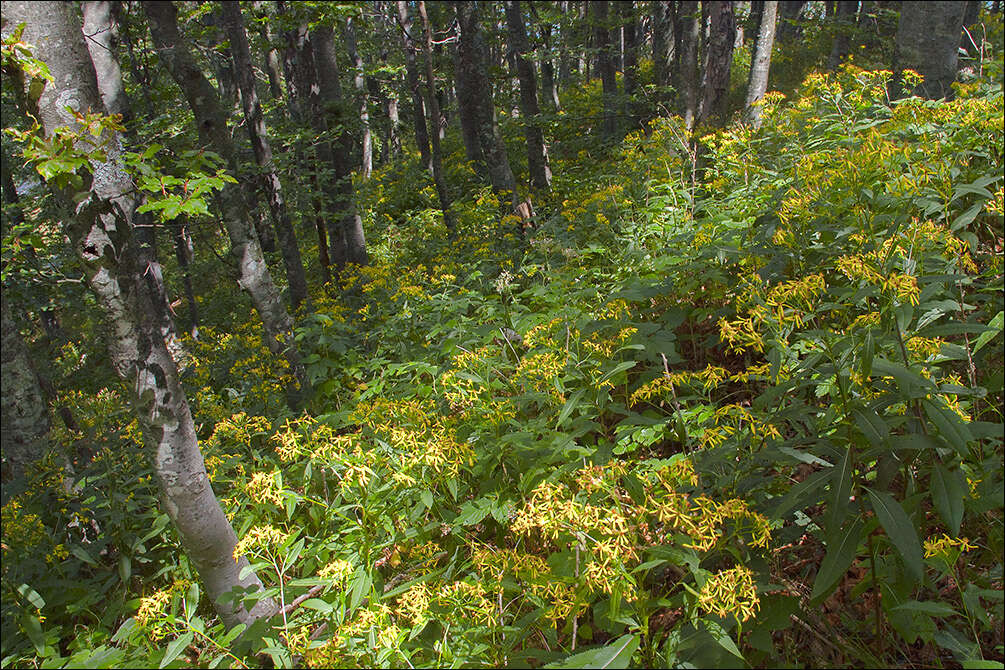
Senecio ovatus (G. Gaertn. & al.) Hoppe ssp. ovatus, syn.: Jacobaea ovata G. Gaertn. & al., Senecio fuchsii C. C. Gmel., Senecio nemorensis subsp. fuchsii (C. C. Gmel.) Ces.Family: Compositae GisekeEN: wood ragwort, DE: Fuchssche Greiskraut, Fuchs-Greiskraut, Fuchskreuzkraut, Kahles Hain-GreiskrautSlo.: Fuchsov grintDat.: Aug. 10. 2008Lat.: 45.28983 Long.: 14.20270Code: Bot_0288/2008_DSC2400Picture file names: from Senecio-ovatus_raw_1 to Senecio-ovatus_raw_10.Habitat: steep mountain slope, east aspect; Fagus sylvatica forest; calcareous ground; in shade, elevation 1.350 m (4.430 feet); average precipitations ~ 2.200 mm/year, average temperature 7-8 deg C, Mountain Sub-Mediterranean phytogeographical region. Substratum: soil.Place: Istria, Uka mountain group, north of Mt. Vojak, almost on top of the mountain ridge above to the road to the top, Rijeka region, Croatia EC.Comment: Senecio ovatus ssp. ovatus is native to central and southeast Europe but it is now naturalized or alien to UK and part of Scandinavia. There are a few very closely related taxa, which differ in slightly in their pubescens, leaf shape and average number of florets in their flower heads. It is not always easy to distinguish them because these traits are all variable. These stands on Mt. Uka, a mountain, which is full of botanical attractions and which dominates (with its 1.401 m height) the whole Kvarner bay of Adriatic Sea and Kvarner archipelago islands, are the largest I've seen.All species od the genus Senecio are seriously poisonous. They contain Pyrrolizidinalkaloides, which are known carcinogen and mutagen substances. Animals dont eat them when grazing, however, if the plants come into hay they may cause serious problems for cattle. Ref.:(1) W.K. Rottensteiner, Exkursionsflora fr Istrien, Verlag des Naturwissenschaftlichen Vereins Krten (2014), p 281.(2) A. Martini et all., Mala Flora Slovenije (Flora of Slovenia - Key) (in Slovenian), Tehnina Zaloba Slovenije (2007), p 669.(3) R. Domac, Flora Hrvatske (Flora of Croatia) (in Croatian), kolska Knjiga, Zagreb (1994), p 357.(4) D. Aeschimann, K. Lauber, D.M. Moser, J.P. Theurillat, Flora Alpina, Vol. 2., Haupt (2004), p 504.Camera: Nikon D70 /Nikkor Micro 105mm/f2.8 and AF-S Nikkor 18-70mm/f3.5-4.5G ED
-
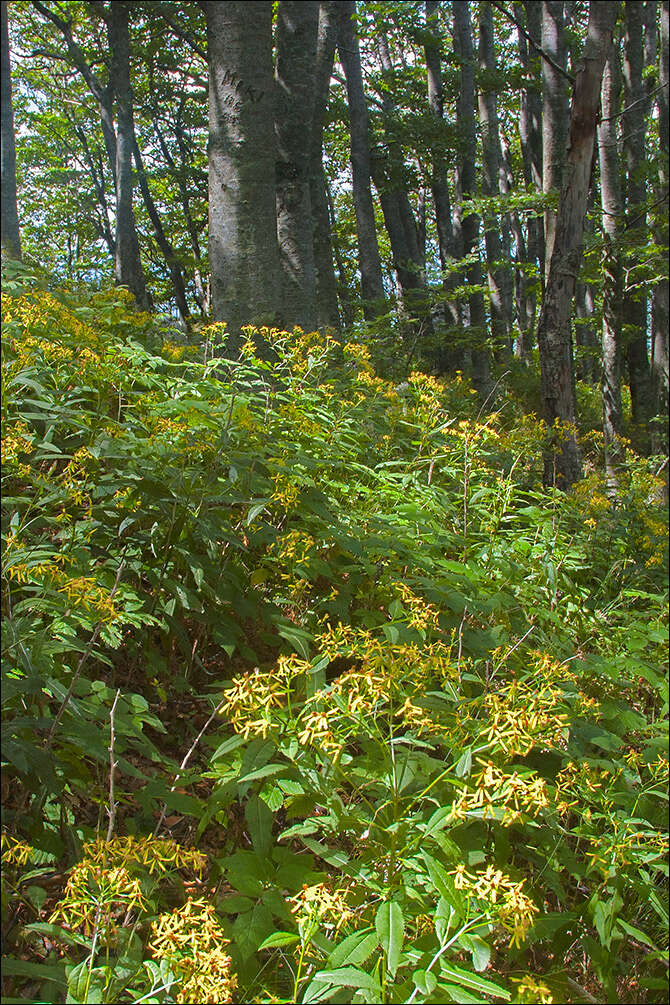
Senecio ovatus (G. Gaertn. & al.) Hoppe ssp. ovatus, syn.: Jacobaea ovata G. Gaertn. & al., Senecio fuchsii C. C. Gmel., Senecio nemorensis subsp. fuchsii (C. C. Gmel.) Ces.Family: Compositae GisekeEN: wood ragwort, DE: Fuchssche Greiskraut, Fuchs-Greiskraut, Fuchskreuzkraut, Kahles Hain-GreiskrautSlo.: Fuchsov grintDat.: Aug. 10. 2008Lat.: 45.28983 Long.: 14.20270Code: Bot_0288/2008_DSC2400Picture file names: from Senecio-ovatus_raw_1 to Senecio-ovatus_raw_10.Habitat: steep mountain slope, east aspect; Fagus sylvatica forest; calcareous ground; in shade, elevation 1.350 m (4.430 feet); average precipitations ~ 2.200 mm/year, average temperature 7-8 deg C, Mountain Sub-Mediterranean phytogeographical region. Substratum: soil.Place: Istria, Uka mountain group, north of Mt. Vojak, almost on top of the mountain ridge above to the road to the top, Rijeka region, Croatia EC.Comment: Senecio ovatus ssp. ovatus is native to central and southeast Europe but it is now naturalized or alien to UK and part of Scandinavia. There are a few very closely related taxa, which differ in slightly in their pubescens, leaf shape and average number of florets in their flower heads. It is not always easy to distinguish them because these traits are all variable. These stands on Mt. Uka, a mountain, which is full of botanical attractions and which dominates (with its 1.401 m height) the whole Kvarner bay of Adriatic Sea and Kvarner archipelago islands, are the largest I've seen.All species od the genus Senecio are seriously poisonous. They contain Pyrrolizidinalkaloides, which are known carcinogen and mutagen substances. Animals dont eat them when grazing, however, if the plants come into hay they may cause serious problems for cattle. Ref.:(1) W.K. Rottensteiner, Exkursionsflora fr Istrien, Verlag des Naturwissenschaftlichen Vereins Krten (2014), p 281.(2) A. Martini et all., Mala Flora Slovenije (Flora of Slovenia - Key) (in Slovenian), Tehnina Zaloba Slovenije (2007), p 669.(3) R. Domac, Flora Hrvatske (Flora of Croatia) (in Croatian), kolska Knjiga, Zagreb (1994), p 357.(4) D. Aeschimann, K. Lauber, D.M. Moser, J.P. Theurillat, Flora Alpina, Vol. 2., Haupt (2004), p 504.Camera: Nikon D70 /Nikkor Micro 105mm/f2.8 and AF-S Nikkor 18-70mm/f3.5-4.5G ED
-
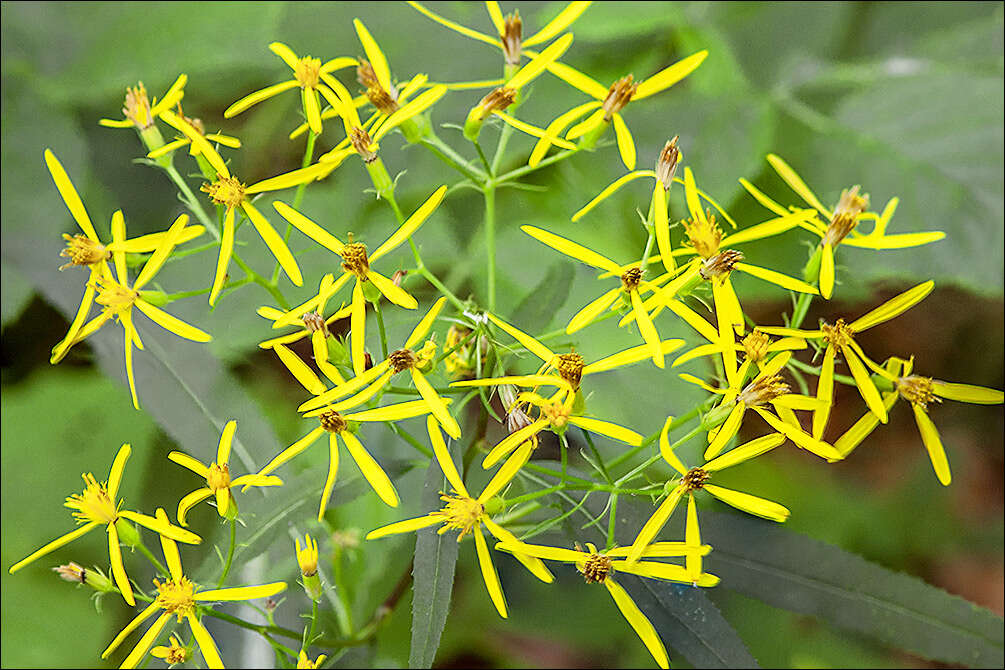
Senecio ovatus (G. Gaertn. & al.) Hoppe ssp. ovatus, syn.: Jacobaea ovata G. Gaertn. & al., Senecio fuchsii C. C. Gmel., Senecio nemorensis subsp. fuchsii (C. C. Gmel.) Ces.Family: Compositae GisekeEN: wood ragwort, DE: Fuchssche Greiskraut, Fuchs-Greiskraut, Fuchskreuzkraut, Kahles Hain-GreiskrautSlo.: Fuchsov grintDat.: Aug. 10. 2008Lat.: 45.28983 Long.: 14.20270Code: Bot_0288/2008_DSC2400Picture file names: from Senecio-ovatus_raw_1 to Senecio-ovatus_raw_10.Habitat: steep mountain slope, east aspect; Fagus sylvatica forest; calcareous ground; in shade, elevation 1.350 m (4.430 feet); average precipitations ~ 2.200 mm/year, average temperature 7-8 deg C, Mountain Sub-Mediterranean phytogeographical region. Substratum: soil.Place: Istria, Uka mountain group, north of Mt. Vojak, almost on top of the mountain ridge above to the road to the top, Rijeka region, Croatia EC.Comment: Senecio ovatus ssp. ovatus is native to central and southeast Europe but it is now naturalized or alien to UK and part of Scandinavia. There are a few very closely related taxa, which differ in slightly in their pubescens, leaf shape and average number of florets in their flower heads. It is not always easy to distinguish them because these traits are all variable. These stands on Mt. Uka, a mountain, which is full of botanical attractions and which dominates (with its 1.401 m height) the whole Kvarner bay of Adriatic Sea and Kvarner archipelago islands, are the largest I've seen.All species od the genus Senecio are seriously poisonous. They contain Pyrrolizidinalkaloides, which are known carcinogen and mutagen substances. Animals dont eat them when grazing, however, if the plants come into hay they may cause serious problems for cattle. Ref.:(1) W.K. Rottensteiner, Exkursionsflora fr Istrien, Verlag des Naturwissenschaftlichen Vereins Krten (2014), p 281.(2) A. Martini et all., Mala Flora Slovenije (Flora of Slovenia - Key) (in Slovenian), Tehnina Zaloba Slovenije (2007), p 669.(3) R. Domac, Flora Hrvatske (Flora of Croatia) (in Croatian), kolska Knjiga, Zagreb (1994), p 357.(4) D. Aeschimann, K. Lauber, D.M. Moser, J.P. Theurillat, Flora Alpina, Vol. 2., Haupt (2004), p 504.Camera: Nikon D70 /Nikkor Micro 105mm/f2.8 and AF-S Nikkor 18-70mm/f3.5-4.5G ED
-
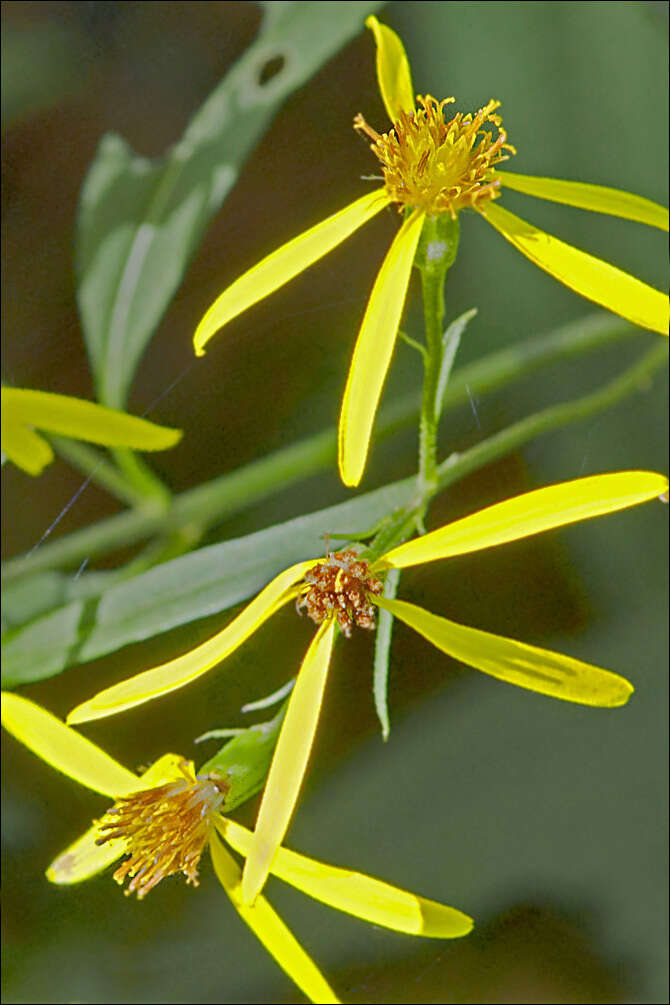
Senecio ovatus (G. Gaertn. & al.) Hoppe ssp. ovatus, syn.: Jacobaea ovata G. Gaertn. & al., Senecio fuchsii C. C. Gmel., Senecio nemorensis subsp. fuchsii (C. C. Gmel.) Ces.Family: Compositae GisekeEN: wood ragwort, DE: Fuchssche Greiskraut, Fuchs-Greiskraut, Fuchskreuzkraut, Kahles Hain-GreiskrautSlo.: Fuchsov grintDat.: Aug. 10. 2008Lat.: 45.28983 Long.: 14.20270Code: Bot_0288/2008_DSC2400Picture file names: from Senecio-ovatus_raw_1 to Senecio-ovatus_raw_10.Habitat: steep mountain slope, east aspect; Fagus sylvatica forest; calcareous ground; in shade, elevation 1.350 m (4.430 feet); average precipitations ~ 2.200 mm/year, average temperature 7-8 deg C, Mountain Sub-Mediterranean phytogeographical region. Substratum: soil.Place: Istria, Uka mountain group, north of Mt. Vojak, almost on top of the mountain ridge above to the road to the top, Rijeka region, Croatia EC.Comment: Senecio ovatus ssp. ovatus is native to central and southeast Europe but it is now naturalized or alien to UK and part of Scandinavia. There are a few very closely related taxa, which differ in slightly in their pubescens, leaf shape and average number of florets in their flower heads. It is not always easy to distinguish them because these traits are all variable. These stands on Mt. Uka, a mountain, which is full of botanical attractions and which dominates (with its 1.401 m height) the whole Kvarner bay of Adriatic Sea and Kvarner archipelago islands, are the largest I've seen.All species od the genus Senecio are seriously poisonous. They contain Pyrrolizidinalkaloides, which are known carcinogen and mutagen substances. Animals dont eat them when grazing, however, if the plants come into hay they may cause serious problems for cattle. Ref.:(1) W.K. Rottensteiner, Exkursionsflora fr Istrien, Verlag des Naturwissenschaftlichen Vereins Krten (2014), p 281.(2) A. Martini et all., Mala Flora Slovenije (Flora of Slovenia - Key) (in Slovenian), Tehnina Zaloba Slovenije (2007), p 669.(3) R. Domac, Flora Hrvatske (Flora of Croatia) (in Croatian), kolska Knjiga, Zagreb (1994), p 357.(4) D. Aeschimann, K. Lauber, D.M. Moser, J.P. Theurillat, Flora Alpina, Vol. 2., Haupt (2004), p 504.Camera: Nikon D70 /Nikkor Micro 105mm/f2.8 and AF-S Nikkor 18-70mm/f3.5-4.5G ED
-
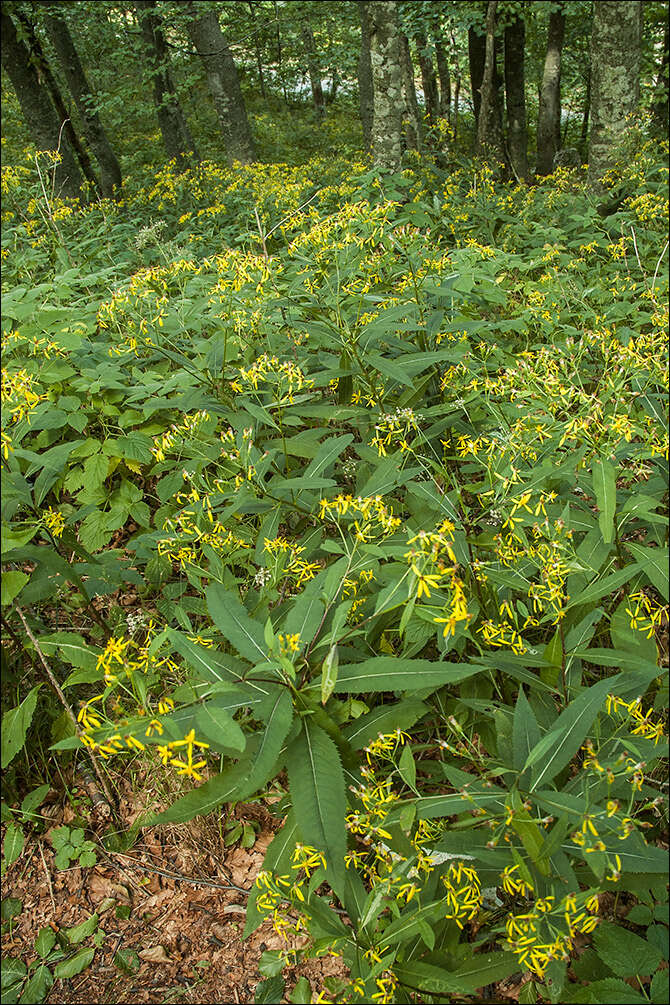
Senecio ovatus (G. Gaertn. & al.) Hoppe ssp. ovatus, syn.: Jacobaea ovata G. Gaertn. & al., Senecio fuchsii C. C. Gmel., Senecio nemorensis subsp. fuchsii (C. C. Gmel.) Ces.Family: Compositae GisekeEN: wood ragwort, DE: Fuchssche Greiskraut, Fuchs-Greiskraut, Fuchskreuzkraut, Kahles Hain-GreiskrautSlo.: Fuchsov grintDat.: Aug. 10. 2008Lat.: 45.28983 Long.: 14.20270Code: Bot_0288/2008_DSC2400Picture file names: from Senecio-ovatus_raw_1 to Senecio-ovatus_raw_10.Habitat: steep mountain slope, east aspect; Fagus sylvatica forest; calcareous ground; in shade, elevation 1.350 m (4.430 feet); average precipitations ~ 2.200 mm/year, average temperature 7-8 deg C, Mountain Sub-Mediterranean phytogeographical region. Substratum: soil.Place: Istria, Uka mountain group, north of Mt. Vojak, almost on top of the mountain ridge above to the road to the top, Rijeka region, Croatia EC.Comment: Senecio ovatus ssp. ovatus is native to central and southeast Europe but it is now naturalized or alien to UK and part of Scandinavia. There are a few very closely related taxa, which differ in slightly in their pubescens, leaf shape and average number of florets in their flower heads. It is not always easy to distinguish them because these traits are all variable. These stands on Mt. Uka, a mountain, which is full of botanical attractions and which dominates (with its 1.401 m height) the whole Kvarner bay of Adriatic Sea and Kvarner archipelago islands, are the largest I've seen.All species od the genus Senecio are seriously poisonous. They contain Pyrrolizidinalkaloides, which are known carcinogen and mutagen substances. Animals dont eat them when grazing, however, if the plants come into hay they may cause serious problems for cattle. Ref.:(1) W.K. Rottensteiner, Exkursionsflora fr Istrien, Verlag des Naturwissenschaftlichen Vereins Krten (2014), p 281.(2) A. Martini et all., Mala Flora Slovenije (Flora of Slovenia - Key) (in Slovenian), Tehnina Zaloba Slovenije (2007), p 669.(3) R. Domac, Flora Hrvatske (Flora of Croatia) (in Croatian), kolska Knjiga, Zagreb (1994), p 357.(4) D. Aeschimann, K. Lauber, D.M. Moser, J.P. Theurillat, Flora Alpina, Vol. 2., Haupt (2004), p 504.Camera: Nikon D70 /Nikkor Micro 105mm/f2.8 and AF-S Nikkor 18-70mm/f3.5-4.5G ED
-
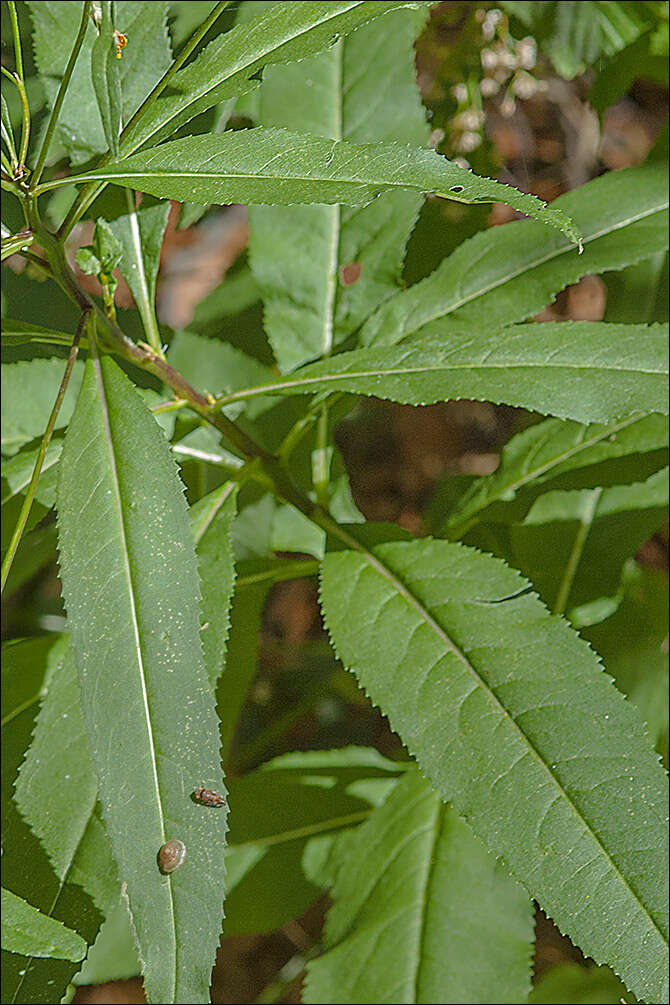
Senecio ovatus (G. Gaertn. & al.) Hoppe ssp. ovatus, syn.: Jacobaea ovata G. Gaertn. & al., Senecio fuchsii C. C. Gmel., Senecio nemorensis subsp. fuchsii (C. C. Gmel.) Ces.Family: Compositae GisekeEN: wood ragwort, DE: Fuchssche Greiskraut, Fuchs-Greiskraut, Fuchskreuzkraut, Kahles Hain-GreiskrautSlo.: Fuchsov grintDat.: Aug. 10. 2008Lat.: 45.28983 Long.: 14.20270Code: Bot_0288/2008_DSC2400Picture file names: from Senecio-ovatus_raw_1 to Senecio-ovatus_raw_10.Habitat: steep mountain slope, east aspect; Fagus sylvatica forest; calcareous ground; in shade, elevation 1.350 m (4.430 feet); average precipitations ~ 2.200 mm/year, average temperature 7-8 deg C, Mountain Sub-Mediterranean phytogeographical region. Substratum: soil.Place: Istria, Uka mountain group, north of Mt. Vojak, almost on top of the mountain ridge above to the road to the top, Rijeka region, Croatia EC.Comment: Senecio ovatus ssp. ovatus is native to central and southeast Europe but it is now naturalized or alien to UK and part of Scandinavia. There are a few very closely related taxa, which differ in slightly in their pubescens, leaf shape and average number of florets in their flower heads. It is not always easy to distinguish them because these traits are all variable. These stands on Mt. Uka, a mountain, which is full of botanical attractions and which dominates (with its 1.401 m height) the whole Kvarner bay of Adriatic Sea and Kvarner archipelago islands, are the largest I've seen.All species od the genus Senecio are seriously poisonous. They contain Pyrrolizidinalkaloides, which are known carcinogen and mutagen substances. Animals dont eat them when grazing, however, if the plants come into hay they may cause serious problems for cattle. Ref.:(1) W.K. Rottensteiner, Exkursionsflora fr Istrien, Verlag des Naturwissenschaftlichen Vereins Krten (2014), p 281.(2) A. Martini et all., Mala Flora Slovenije (Flora of Slovenia - Key) (in Slovenian), Tehnina Zaloba Slovenije (2007), p 669.(3) R. Domac, Flora Hrvatske (Flora of Croatia) (in Croatian), kolska Knjiga, Zagreb (1994), p 357.(4) D. Aeschimann, K. Lauber, D.M. Moser, J.P. Theurillat, Flora Alpina, Vol. 2., Haupt (2004), p 504.Camera: Nikon D70 /Nikkor Micro 105mm/f2.8 and AF-S Nikkor 18-70mm/f3.5-4.5G ED

